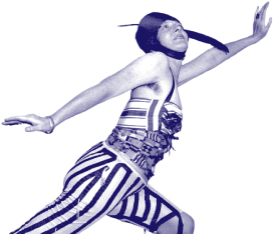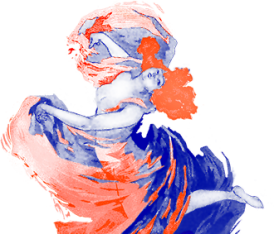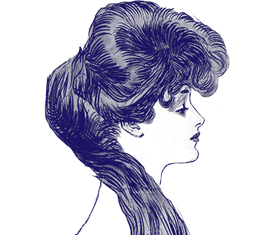HomeNews & Events2011December Body Sweats review in Los...
Thoroughly Modern Elsa
By Brian Kim Stefans,
UCLA Assistant Professor of English
Dec. 16, 2011
The typical thumbnail portrait of the Baroness Elsa von Freytag-Loringhoven usually goes like this. She was the Queen of New York Dada from 1913 to 1923, the first to wear clothes made of discarded clothes and rubbish (including a brassiere made of tin cans). She constructed assemblage-style art in the manner of Marcel Duchamp, and her scatological proclivities may have inspired his seminal Fountain. She was prone to spontaneous "performance,” often in the nude, and was sexually aggressive in a decidedly "masculine” way. She courted Duchamp actively and mocked him in poems (dubbing him "M’ars” — my arse), and chased right to his front lawn in Rutherford, New Jersey the relatively prudish doctor-poet William Carlos Williams, who, legend has it, learned how to box in order to deck her in self-defense.
Since her rediscovery by scholars over a decade ago, photographs of the Baroness have become, in their way, as iconic of the era of Dada as any. Most famous are a pair snapped by International News documenting her "Body Performance Poem” in her Greenwich Village studio, wearing what appears to be a corset made of maritime flags, a striped bathing suit with 12-inch fringes hanging from the knees, and a leather helmet with a single propeller exploding from her temple. The Baroness poses racing forward, as if imitating a Futurist sculpture by Umberto Boccioni, looking like a cross between the gremlin in the Bugs Bunny cartoon (the one who hammers away at an atom bomb as his plane is in vertical descent) and an athlete from Leni Riefenstahl’s documentary about the Berlin Olympics, Olympia (not to be made for another 25 years).
Though a real Baroness by marriage, Elsa von Freytag-Loringhoven — born Elsa Hildegard Plötz in 1874 in the Polish port city of Swinoujscie — had a relatively humble middle-class upbringing, with a reserved Polish mother and a physically abusive German father, and in later years lived a life of teetering on poverty. The Baron in question, whom she married in New York in 1913 before divorcing her previous husband (who had deserted her), absconded with their meager savings in order to return to Germany to fight in the war. Elsa managed to eke out a living as a model while creating most of the writing and art collected in the present volume. She finally returned to Europe in 1923 to live out her last years even poorer than she had been in New York. She befriended the writer Djuna Barnes, best known today as author of Nightwood, who became a great supporter (and object of sexual affection). The Baroness, known in her last years simply as Elsa, died of asphyxiation in Paris in 1927, most likely a suicide, after leaving the gas of her recently acquired, and beloved, ancient potbellied stove turned on.
The range and disparate nature of the Baroness’s work — for it’s now clear that she was, in fact, an artist, even though it’s unlikely that anyone in her time considered her spontaneous performances to be art — arguably makes her a forerunner of artists in the traditions of Fluxus, Happenings, and Conceptualism. All, like Elsa, were practitioners for whom photographic and audio documentation were a necessary corollary to the events, and who often disregarded the border between "art” and "life,” refashioning their appearances to become as iconic as possible (think of Joseph Beuys’s hat and jeans, Andy Warhol’s white mop of hair, Yoko Ono’s placid stare) and ensure the maximum quantity of flashbulbs. She was also one of the only women to take up sound poetry — a poetry of pure phonemes, with no linkage to conventional lexical meanings — in the wake of Hugo Ball’s invention of the genre, though no recordings survive. As if that weren’t enough, the editors of Body Sweats, Irene Gammel (author of a biography of the Baroness, also published by MIT) and Suzanne Zelazo, would also like us to see Elsa as the forerunner of female pop icons like Patti Smith, Lady Gaga, Björk, Nina Hagen, and Courtney Love: extroverted women who were not afraid to dress up, act a little batty, make strong come-ons, and scream and howl on occasion — "constantly risking absurdity” in the words of Lawrence Ferlinghetti in his famous poem describing the quixotic fixations of the artist/acrobat.
It seems slightly absurd to place the Baroness at the head of this band of affluent, powerful media auteurs — she was as unassimilable into the entertainment industry of the 1910s as Lady Gaga was "born into” that of the 00s. But this is symptomatic of a tendency of the editors of this volume to emphasize the theoretical value of the Baroness’s activities, to depict her as a spectacular but abstract creative force that anticipated any number of factors in our present mediascape. For Gammel and Zelazo, it can sometimes seem, the Baroness is an object of cultural studies, not an artist.
But the Baroness was actually a poet most of all. Despite having learned English only upon moving to Kentucky in 1910, she managed to develop an idiosyncratic idiom for her writing largely characterized by her imperfect grammar (which she often refused to have corrected) and the somewhat kitschifying use of archaic forms of address. She also possessed a wide vocabulary that could take in everything from Latinate philosophical verbiage, misty Romantic clichés, and the ad copy copped from the billboards and neon signs of Times Square. She adopted at least one modernist tendency that hasn’t dated well: the etymologically naked neologism, a jamming of two or more very common words together to create a new one, as seen in such works as James Joyce’s Portrait of the Artist as a Young Man and Ulysses and the poems of E.E. Cummings. Quite often the synthesis simply doesn’t pan out: "passionstillbirth” falls pretty flat in my ears, "wombcradle” just seems a calcified poetic commonplace, and while "helljunk” might just enter my vocabulary, "phalluswheel” seems like a doodle from the back of a tattered copy of Freud’s study of female hysteria. Still, von Freytag-Loringhoven was hardly the only writer to indulge in such verbal hijinks; contemporaries such as Abraham Lincoln Gillespie leaned on this simple marker of modernity pretty hard, and without the excuse of having German — a language legitimately full of such conjunctions — as a first language.
These are the basic hallmarks of her style, but the Baroness experimented with many types of poetry, such as the terse, jerky rhyming quatrain, liberally sprinkled with her favorite punctuation mark — the em dash — making some lines and stanzas of her poems distantly reminiscent of Emily Dickinson:
Why didst though go away from me?
Say — why?
art not enslaved by balmy wizardry
out of mine jeweled eye?
…
musk — amber — myrrh and frankincense —
gold — damask — ivory —
mine gothic cathedral —
is that upbuild in vain
for thee — ?
(from "Cathedral”)
But these moments of quasi-formal coalescence disappear quickly in the rapid-fire method of her delivery. More characteristic are what I would call her "word streams,” which are poems containing only a single word per line, made to be read quickly, the need for speed being one of the many modernist mantras of the decade. (Bob Brown would develop his "readies” in the 1930s, poems read one word at a time as they zipped past on a mechanical scroll; the Baroness’s work, which often seems too fast for contemplative fireside reading, would have been perfect for his machines.) Here’s one I’ll quote in its entirety, since it might entail some scrolling to read on a standard computer screen, a requirement that seems, from a distance, to play into the Baroness’s plan of making us play with her in order to get to the heart of her poems:
Pastoral
(To Bernice)
(Improved)
She’s
Agape —
Upsky —
Ogling
Wry —
Uncouth
Shape:
Quiltbeggarskirt —
Near
Pauperhome —
Upcountry —
Sitting
Sheaf —
Smoking
Surreptitious
Cigarette —
This
Chill
Marcheve.
Well —
Say —
She —
Of
Pasty
Melancholy —
Trick
Memory —
Strolling
Over
From
Pary —
Glooming
Down Germany —
Obsolete —
Spotting
Me —
Her
Mimicry
Sinister – – –
Some
Queer
Dope
Sister!
Don’t
Mope —
Ole
Misanthrope
I
Blame
Thy
Netherslipslope
Not
One
Bit —
Kid —
Nope!
Unfortunate
That’s
What
I
Calls
It!
I’m
Blue
As
Sin —
Hell —
What is remarkable about this technique and the Baroness’s other experiments with graphics and the spatialization of words is that she wrote all of her poems by hand, never using a typewriter as a compositional tool. Scholars of modernist poetry often tend to focus on the role the machine played in altering the poets’ sense of space and speed on the page, but these poems can’t play a role in that discussion. The Baroness wrote with the all-caps setting on, and had a remarkable handwriting style: neat, boxy, seemingly Bauhaus-inspired, but nonetheless reflecting in its gestural qualities the hothouse decadence of the late-Symbolist poets of her youth, suggestive of art nouveau in the slight extension of the bottom bar of the "E” or the florid, lengthened descender of a capital "Y.” Egyptian might be a good adjective for this quality.
She also had a great way of assimilating the heaps of commercial language and imagery that surrounded her as she walked the New York streets. Body Sweats contains a wonderful photograph of six-story freestanding ad for Pepsodent toothpaste, with a billboard for Camel cigarettes at its base and one for Chevrolet topping it, totem-pole-like, and though the photo is from 1931, four years after the Baroness’s death, it suggests the muddle of invented, trademarked and, due to their anachronism, perversely "poetic” words that whipped around in her skull as she scribbled. Here’s the Baroness:
Tootsie kisses Marshall’s
Kippered health affinity
4 out of 5 — after 40 — many
Before your teeth full-o’
Pep with 10 nuggets products
Lighted Chiclets wheels and
Axels — carrying Royal
Lux Kamel hands off the
Better Bologna’s beauty —
Get this straight — Wrigley’s
Pinaud’s heels for the wise —
Nothing so Pepsodent — soothing
Pussy Willow — kept clean
With Philadelphia Cream
Cheese.
They satisfy the man of
Largest mustard underwear —
No dosing —
Just rub it on.
(from "Subjoyride”)
Note how Elsa skillfully contains this cacophony with off-rhymes ("clean”/”cream”/”cheese”) and crisp enjambments, and then ties a bow at the end with an efficient Surrealist image ("a man of / Largest mustard underwear”) that is erotic, perverse and, with its aping of commercial language in the final line, both a testament to convenience and an invitation to sex. This hapless hunger for the garbage language of commerce and the denaturalized products of America would not emerge as a major force in poetry until Frank O’Hara, who often mingled the pedestrian with references to great works of art. But unlike the words in O’Hara’s chatty monologues, the Baroness’s language is unlinked, for the most part, with a speaking voice. The shifts are mechanical, sudden, and jerky like a subway ride, and her spontaneous metrics, while chaotic and unrelenting at first, actually anticipate much of what late 20th century experimental poets like Charles Bernstein would become preoccupied with: the unlinking of the poem with the "natural” voice of an speaker.
Radical though it was, von Freytag-Loringhoven’s work was not altogether neglected. Ezra Pound, who famously prized the "innovators” above all other types of poets (especially those nasty "diluters”), championed her and lambasted the establishment for ignoring her in his Cantos ("The immense cowardice of advertised literati/& Elsa Kassandra, ‘the Baroness’/von Freitag etc. sd/ several true things,” Canto XCV). The Baroness appeared more frequently than any other writer in The Little Review, the dominant avant-garde literary magazine edited by Margaret Anderson and Jane Heap, where parts of Joyce’s Ulysses first appeared. She has not been completely ignored in the past decade, either: In addition to Gammel’s biography, a small collection of the Baroness’s poetry, Subjoyride, appeared from Green Integer in 2005.
Body Sweats: The Uncensored Writings fills out the portrait significantly, including not only her published work but poems retrieved from handwritten manuscripts, often finely decorated with doodles and diagrams. Gammel and Zelazo’s book doesn’t, in the end, succeed in, or even attempt, evaluating what the Baroness means to contemporary poetry, opting instead for a cultural critical angle that considers her persona before her art; and it’s true that this might, in fact, be the most interesting thing about her from today’s vantage point. The futurist (with a small "f”) element in discussions of poetry, the full-frontal excitement that accompanies the discovery of new poetic forms — which are then read as new social forms — has largely disappeared from the contemporary poetic scene. The most "progressive” of present-day poets are often recycling moves from previous avant-garde moments, while the experimental wing of the nation’s MFA programs pump out poems that have a vaguely "elliptical” quality. Much of this work is interesting and forward-looking, but it lacks the intoxication of the modernist injunction to change not just art but life — the ecstasy, torment, and drive to be contemporary that you get in works like Rimbaud’s "Saison en enfer,” Apollinaire’s "Zone,” or Williams’s 1923 Spring and All (itself, as Body Sweats makes clear, influenced by the Baroness’s restless energy).
In fact, the editors of Body Sweats have aimed their book, which after all is being published by MIT, more at academics than at artists. Their method of tying all of the activities of the Baroness’s work together revolves around a refrain that occurs in the first or second sentence of each chapter introduction, that of the "bodily” nature of the Baroness’s work. While I’m sure that this discourse is very important in some quarters of academia, I don’t understand what a sentence like "The Baroness’s poems of nature are bodily portraits” means. We’re told that the poems "extend the sensuality of the Baroness’s body into nature, challenging the dominating machine focus of the Dada movement and the era,” but it’s just as likely that she hadn’t quite rid herself of her early aestheticist leanings, sensual and anti-machine as they probably were. And when does the obsession with the body that Gammel and Zelazo celebrate become the fascistic cult of the body that we know so well from the films of Riefenstahl?
Another shortcoming of Body Sweats is the lack of inclusion of any of the Baroness’s early writing in German. She had intense encounters with the Arts and Crafts movement (often in the form of her affairs and marriages, but she modeled for them as well, which she hated) and there are additional elements of her writing suggesting that she never completely abandoned concepts learned from her days with the aesthetes. Some of her poems exhibit sort of deistic reverence for an all-encompassing God — I don’t think she is being quite as ironic about this as the editors suggest — and her recurring bouts with anti-Semitism (as expressed in neologisms like "New-Zion-York” and "Kykianity”) seem more than a product of poor taste. She was 39 when she moved to New York, and though for most of her previous life she had been relatively untethered to any major cultural movements, and was no doubt uncompromisingly singular, it would be safer to say she was "reborn” Dada rather than born Dada.
But perhaps I am just describing a different book, one for the future, for editors and critics with different questions. This volume is beautifully, even lovingly, typeset, attempting to preserve all of the Baroness’s eccentricities, and gives the reader even more to ponder with the many reproductions of handwritten, illustrated originals. The annotations are rich, and, for all of my kvetching, the theoretical framework of the volume, which is broken into conceptual chapters rather than arranged chronologically, keeps the issue of the Baroness’s place in art and literature hopping, an open question, the Baroness herself living on, unsubdued.
Brian Kim Stefans is is a poet and professor of English (contemporary poetry and new media) at UCLA. His forthcoming book of poems is Viva Miscegenation (MakeNow Press). Prior books include What is Said to the Poet Concerning Flowers (Factory School, 2006) and Fashionable Noise: On Digital Poetics (Atelos, 2003). His website, which houses his many works of digital text art, is arras.net.
See the original review on the Los Angeles Review of Books website
Detail about Body Sweats












